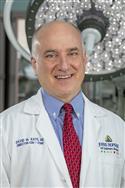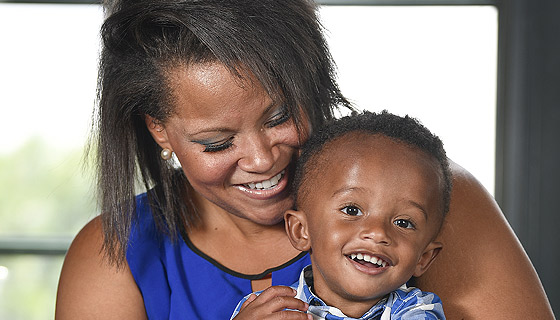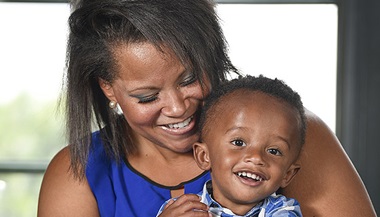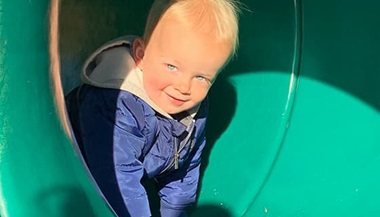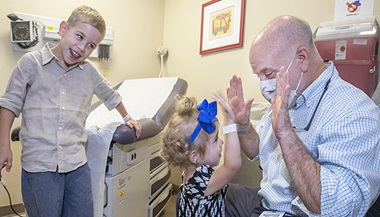Patient Story
Congenital Diaphragmatic Hernia: Samuel's Story
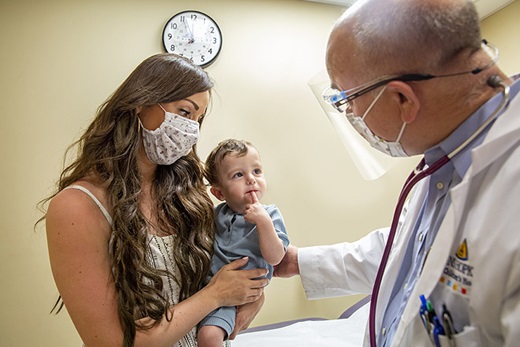
The video on Instagram takes your breath away …
It shows a fragile infant fighting his way through his first week of life under a mass of wires and tubes keeping him alive.
His eyes flutter open for the very first time. Blinking, blinking ...
His entire face is a question mark.
What baby Samuel couldn’t possibly know was that the biggest questions had already been answered for him.
The News
When Samuel’s parents learned their baby would be born with congenital diaphragmatic hernia (CDH), they were stunned — and mystified.
“I had never even heard of this before,” Cara says.
Congenital diaphragmatic hernia (CDH) is a condition where the diaphragm, the muscle separating the abdomen from the chest, does not form properly, allowing the abdominal organs to push up into the chest, choking off lung growth.
The doctor who gave them the diagnosis didn’t leave them with much hope. Cara was informed that the national survival rate for babies with CDH averaged around 50 percent.
Quietly devastated, she shared the news about her unborn baby’s diagnosis on her Instagram page.
Cara is a “mommy blogger.” She has been posting about her family and connecting with other moms ever since the birth of her daughter, 4-year-old Aria.
Her Instagram followers have watched Aria grow, and they even know about the sad loss of a baby sister at birth a few years ago.
But now, this? What to do?
As it turned out, some of Cara’s followers had some ideas. She learned about a non-profit organization that helps CDH families with information and a network of support.
Through those channels, she quickly began to learn about an encouraging option down south …
What Is Possible
Johns Hopkins All Children’s Hospital in St. Petersburg, Florida, founded the first inpatient center in the country dedicated solely to the treatment of congenital diaphragmatic hernia.
Babies treated at the Center for Congenital Diaphragmatic Hernia have a survival rate that exceeds national benchmarks — a rate greater than 90 percent.
David Kays, M.D., is the center’s founder and director. He has treated more than 500 babies with CDH over 30 years in practice.
“What we really want people to know is that virtually all of these babies can survive,” Kays says, “and assuming they have no additional major anomalies, they can not only survive, but do very well. And that is just as important to us as survival.”
A phone consult with Kays and the care team sealed the deal for Cara and her husband, Aaron.
“We just knew in our hearts that’s where we needed to be,” Cara says.
The family prepared for a big life change. They moved to St. Petersburg in early 2020 and settled into a Ronald McDonald House a few weeks before the baby was scheduled for delivery.
But the long journey was just beginning. The path would not be an easy one for baby or family.
Welcome, Baby
Little Samuel came into the world on March 4, 2020. As MRI scans had indicated, his case was severe.
“If it’s a small hole with left-sided diaphragmatic hernia, the intestines migrate up into the chest,” Kays says, describing the spectrum of severity in these babies.
“With a medium-sized hole, you have the intestines — that’s the small bowel and colon — but also the stomach and spleen pushed up into the chest. With a large hole, you have all those things plus some of the liver. With an extra-large hole, you have all of that, plus even more of the liver pushed up into the chest.”
Samuel’s left diaphragm was almost non-existent.
A diagnosis of more than 20 percent of the “liver up” is considered to be highly severe. Samuel had fought his way into the world with 40 percent of his “liver up.”
He had much to overcome.
The day after Samuel was born, he was placed on an extracorporeal membrane oxygenation (ECMO) machine. It’s the highest form of life support (for the heart and lungs), but not uncommon for babies with more severe CDH.
Cara and her family kept the faith.
“Early on in my pregnancy, I had decided, OK, there are going to be so many unknowns throughout this journey, I’m just going to trust, and not let fear take over.”
That same day, soon after going onto ECMO, Kays and his team performed Samuel’s repair surgery, meticulously moving the tiny organs down into the abdomen, then sewing a patch into place where the diaphragm should have been.
Samuel made it smoothly through the surgery.
Day by day, he began to breathe a little better, to stabilize, to grow.
The care team continued to protect Samuel’s brain while giving his lungs every chance to get stronger.
Within two weeks, Samuel was able to come off ECMO.
Cara’s Instagram photos marked his victories, large and small. There was the day she first got to hold him, the day he got his breathing tube out, the day he first took a bottle.
Things were moving forward, but the family had to be resilient too. After all, they were plodding their way through an astonishing year. Not only was their baby boy in a fight for his life, but the COVID-19 pandemic was altering all of their lives.
A Setback, A Launch
At the end of April, just when Samuel was getting close to being discharged, a setback.
Samuel was having trouble with reflux, something common in babies with CDH. Scans and tests revealed he had a misshapen esophagus, and he was aspirating into his lungs.
Samuel would need anti-reflux surgery, and to have a g-tube installed to serve as an extra avenue of nutrition while he learned to eat more on his own.
It was disappointing, but this little boy had come so far.
“There was never a moment where we felt like coming here was the wrong decision,” Cara says. “We felt we were in the best possible hands. So thankful to be with people who are so highly skilled.”
Samuel recovered from his last surgery, and after 71 days in the hospital, it was finally time to prepare to go home.
With a host of high hopes, this proven little fighter would take his very first road trip — to New Jersey.
A Year Later
In his first year at home, Samuel has made great progress.
He has gained weight, and he’s eating well on his own.
He has enjoyed so many “firsts” outside of the hospital, the kind that little ones are supposed to have … peekaboo games with his sister, a first time on a playground swing, a “smash cake” for his birthday.
He’s learning quickly — even things like how to sneak food to the family dog from his high chair.
There is much for this little boy to look forward to.
Throughout her pregnancy and Samuel’s first year, Cara has received a world of support from family, friends, and her followers on Instagram. But she has been able to offer support as well.
She hopes Samuel’s brave journey will inspire other people.
“I don’t want families to think there is no hope for these children with CDH,” she says.
“There is so much hope. One day, Samuel will tell his own story.”
Samuel's Doctor
Johns Hopkins All Children's Center for Congenital Diaphragmatic Hernia
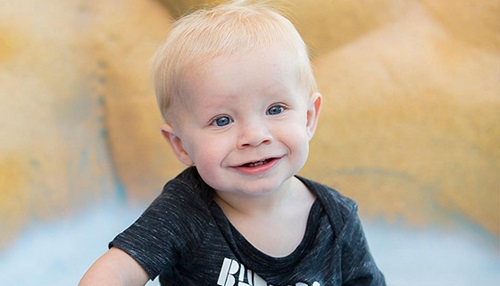
At the Johns Hopkins All Children’s Center for Congenital Diaphragmatic Hernia (CDH) in St. Petersburg, Florida, families find hope during a time that may otherwise feel hopeless. Led by CDH expert David Kays, M.D., our team combines compassionate care, innovative techniques, and cutting-edge technology and equipment to treat babies with CDH.

